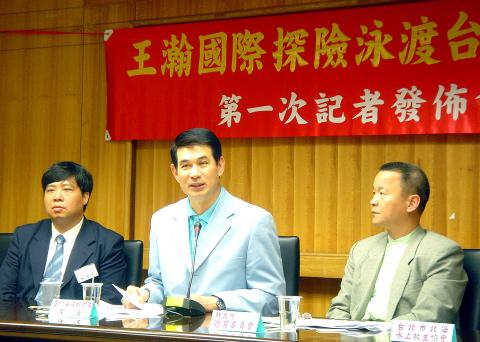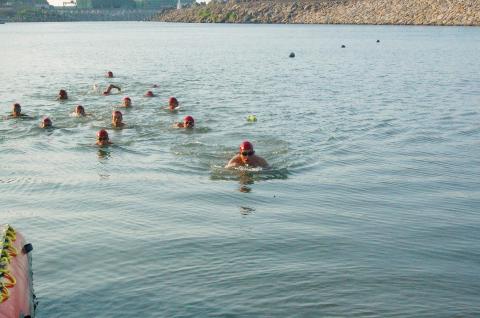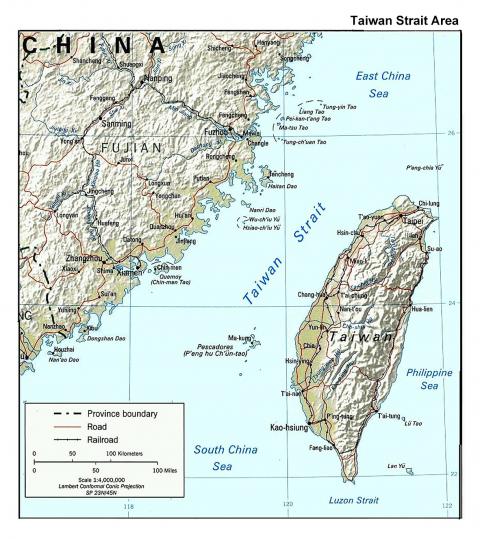Aug. 19 to Aug. 25
After swimming for 8.5 hours and subsisting on just bread and ginger soup, an exhausted Wang Han (王瀚) reached the shores of Morocco.
The former actor’s feat made the headlines on Aug. 24, 1986, with the United Daily News (聯合報) calling it a “risky journey across the demonic strait.”

Photo: CNA
Some praised him as the “first Chinese person to swim across the Strait of Gibraltar,” while others noted that he was the “first in the East.” This was a time when everyone in Taiwan was still taught to identify as Chinese, and Wang claimed that he did it for the “spirit of the Chinese people.”
Wang would end up traversing, whether alone or in a relay team, 11 more major world straits over the following 12 years. However, there was one challenge left, one that was closest to home: The Taiwan Strait, which was off-limits for political reasons.
ACROSS THE DEMON STRAIT

Photo: Yang Pei-hua, Taipei TImes
While most reports note the Strait of Gibraltar exploit as the beginning of Wang’s legendary run, he made his maiden long-distance voyage here in Taiwan in late 1985. A January 1986 report in Television Weekly (電視週刊) details his swim from Pingtung’s Donggang Township (東港) to Siaoliouciou island (小琉球).
This attempt was sponsored by the actor’s guild Wang belonged to, and was meant to “demonstrate the resilient and adventurous spirit of the Chinese people and to boost the image of entertainers and performers.”
Wang was never formally trained as a swimmer. Born in 1954 in rural Hsinchu, he honed his aquatic skills in the Toucian River (頭前溪) before he became acquainted with the ocean during college. At the age of 31, he walked away from acting and modeling to focus on swimming.

Photo courtesy of Wikimedia Commons
After making it to Siaoliouciou in just over six hours, Wang told the press that he would tackle the English Channel next. It isn’t clear why he ended up crossing the Strait of Gibraltar first, but there he was on the shores of Tarifa, Spain on Aug. 22, 1986. He warmed up for about an hour, and plunged in.
Despite his leg cramping up just an hour into the ordeal and strong currents pushing against him, Wang made it. The water was quite cold; fortunately the supply boat was stocked with ginger tea that kept him warm. He collapsed on the beach for a moment before pushing himself up to greet the crowd running toward him.
During the ensuing celebration, the Spanish host noted that only three people had completed the feat in modern history before Wang: two Europeans and a South Asian, making him the first East Asian to make the list.
“What’s inspiring is that Wang is not a professionally-trained swimmer,” the Minsheng Daily (民生報) reported. “Experts have criticized his form as less than ideal, and there are many people who have better stamina and skills,” it stated before praising his determination and perseverance that “embodied the spirit of the Chinese race.”
ULTIMATE GOAL
Huang swam the English Channel next in 1988, followed by the Bosphorus in 1989 and a channel around Maui, Hawaii in 1990, consistently completing one challenge per year until 1998. Three of these were solo trips while nine were done with a relay team. News footage of his team crossing the US-Canadian Strait of Juan de Fuca in 1993 and Australia’s Cleveland Bay in 1996 can be found on YouTube. Due to the prevalence of sharks in the Australian waters, the team had to swim in shark-proof cages, a first for Wang.
Wang told the press after crossing the Tsugaru Strait in 1994 that it was his eighth conquest and that he had four more to go, the final one being the Taiwan Strait. However, his 12th journey was across the Strait of Sicily in 1998; he presumably could not cross the Taiwan Strait due to tense relations between Taiwan and China, especially with the Third Taiwan Strait Crisis breaking out just two years before.
It wasn’t until 2007 that Wang announced plans to realize his dream, recruiting 24 young athletes who would each swim one hour at a time. He lamented that during all this time, the closest strait to home was also the farthest, and it wouldn’t have been possible without connections through famed Olympian sprinter Chi Cheng (紀政).
“I’m accustomed to spending my days in the ocean,” he told TVBS. “Although I haven’t challenged any strait in the past 10 years, I have been preparing this whole time to cross the Taiwan Strait.”
But the currents were unforgiving, and the team had advanced just 23km in 24 hours, while getting swept back 2km in the last hour. Coupled with the supply boat running low on fuel, the swimmers aborted the mission.
Vowing to give it another shot, Wang started recruiting people again in January 2008, but curiously there are no news items about the results — indicating that he either never made the trip or failed again.
Taiwan in Time, a column about Taiwan’s history that is published every Sunday, spotlights important or interesting events around the nation that have anniversaries this week.

This month the government ordered a one-year block of Xiaohongshu (小紅書) or Rednote, a Chinese social media platform with more than 3 million users in Taiwan. The government pointed to widespread fraud activity on the platform, along with cybersecurity failures. Officials said that they had reached out to the company and asked it to change. However, they received no response. The pro-China parties, the Chinese Nationalist Party (KMT) and Taiwan People’s Party (TPP), immediately swung into action, denouncing the ban as an attack on free speech. This “free speech” claim was then echoed by the People’s Republic of China (PRC),

Exceptions to the rule are sometimes revealing. For a brief few years, there was an emerging ideological split between the Democratic Progressive Party (DPP) and Chinese Nationalist Party (KMT) that appeared to be pushing the DPP in a direction that would be considered more liberal, and the KMT more conservative. In the previous column, “The KMT-DPP’s bureaucrat-led developmental state” (Dec. 11, page 12), we examined how Taiwan’s democratic system developed, and how both the two main parties largely accepted a similar consensus on how Taiwan should be run domestically and did not split along the left-right lines more familiar in

Specialty sandwiches loaded with the contents of an entire charcuterie board, overflowing with sauces, creams and all manner of creative add-ons, is perhaps one of the biggest global food trends of this year. From London to New York, lines form down the block for mortadella, burrata, pistachio and more stuffed between slices of fresh sourdough, rye or focaccia. To try the trend in Taipei, Munchies Mafia is for sure the spot — could this be the best sandwich in town? Carlos from Spain and Sergio from Mexico opened this spot just seven months ago. The two met working in the

Many people in Taiwan first learned about universal basic income (UBI) — the idea that the government should provide regular, no-strings-attached payments to each citizen — in 2019. While seeking the Democratic nomination for the 2020 US presidential election, Andrew Yang, a politician of Taiwanese descent, said that, if elected, he’d institute a UBI of US$1,000 per month to “get the economic boot off of people’s throats, allowing them to lift their heads up, breathe, and get excited for the future.” His campaign petered out, but the concept of UBI hasn’t gone away. Throughout the industrialized world, there are fears that